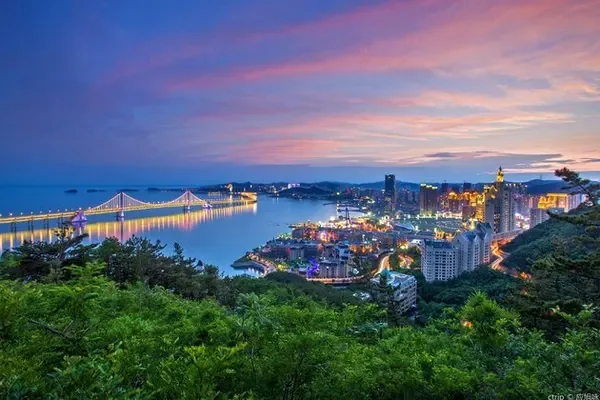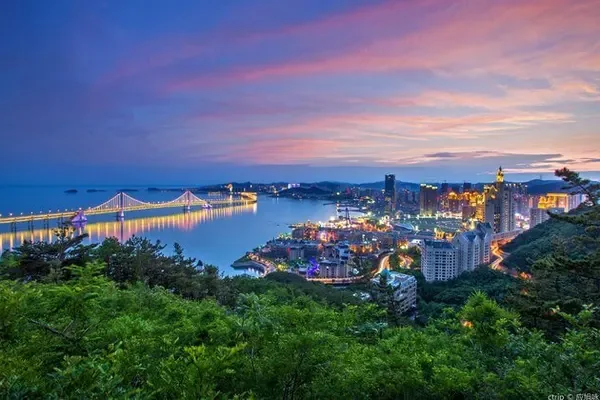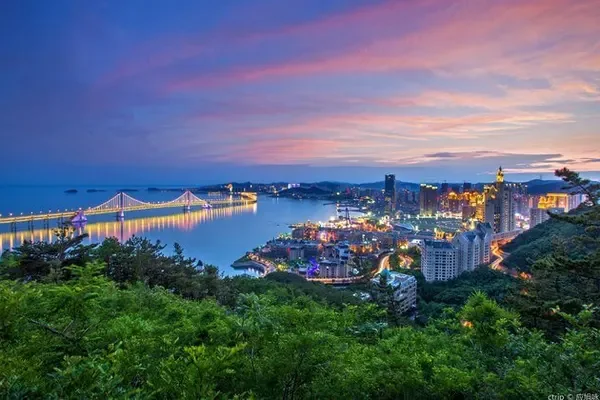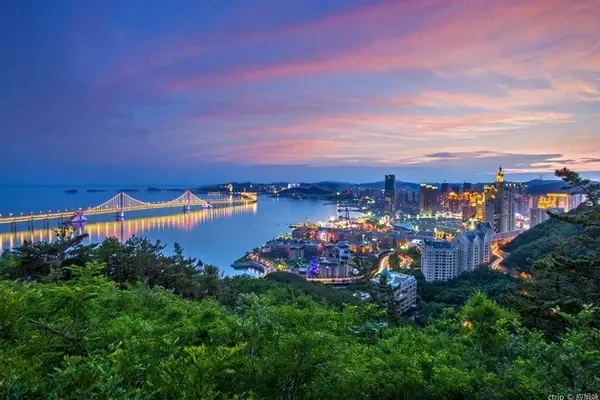In the southernmost part of Shanxi is Yuncheng, a prefecture-level city that governs a series of county-level cities and county-level counties around it. Yuncheng is a very old site. It was called Hedong in ancient times, which is the east of the Yellow River. In the time of Yao, it belonged to the land of Tang, and Puban, the capital of Shun, and Anyi, the capital of Yu, were all on this territory. However, these ancient place names have long been buried in the ground and cannot be seen. I came to Yuncheng to see another historic site.
Since Yuncheng is in the east of the river, it means that it is next to the Yellow River. The Yellow River is a big river with wide and violent waves. The Chinese people's deep-rooted mother river plot of the Yellow River made the first large-scale reservoir in New China start on the Yellow River, which is the Sanmenxia Reservoir. Soviet water conservancy experts participated in the construction of the Sanmenxia Reservoir. It is not clear whether they played a positive or negative role. However, the lessons of the Sanmenxia Project did not teach those Soviet experts a profound lesson. Several years later, they still received new lessons in the construction of the Aswan Water Conservancy Project in Egypt. Regardless of the other problems of the Sanmenxia Reservoir, first of all, the flooding of cultivated land in the reservoir area after water storage is a problem. The construction of the Aswan Dam in Egypt in 1960 also submerged a large area of land, including several ancient Egyptian temples. At that time, UNESCO convened many experts, and they started work in 1964 to relocate the temple that was about to be submerged by the reservoir to above the water storage line. When I went to Egypt before, I went to Abu Simbel and the Temple of Philae. When we built the Sanmenxia Reservoir, we had a similar experience. We needed to relocate the cultural relics and historic sites that were about to be submerged. This is the Yongle Palace. We didn't sit in the United Nations at that time, and of course they didn't help us organize experts. We completed the overall relocation of Yongle Palace entirely on our own. The Yongle Palace was relocated in 1959 before the relocation of the Egyptian temple, and it was completed in 1964. It was the first complete relocation of an ancient building in the world.
According to the records of the inscriptions on the cultural relics of Yongle Palace, there was a village-level Taoist Temple Tianzun Hall in Hequ before Li Longji's Tianbao five years (747 AD). This meander is two miles south of Puban, the capital of Shun, and this village is Yongle Town. During the Tang, Song, Liao, Jin, and Yuan dynasties, Confucianism, Buddhism, and Taoism emerged one after another in China, each leading the way for a hundred years. In fact, Taoism has always been tepid, without great ups and downs. When Genghis Khan rose, he had a very important minister, Yelu Chucai. Under the guidance of Yelu Chucai, Genghis Khan gradually became aware of Taoism. In the 14th year of Emperor Taizu of the Yuan Dynasty (1219), Genghis Khan sent envoys to meet Qiu Chuji, a Taoist celebrity on his way to the western expedition to Huarazmo. Qiu Chuji was the head of Quanzhen Taoism at that time. In the 6th year of Xingding (1222) of Wanyan Xun of Jin Xuanzong, he took a few entourages to the Mongolian Army's Western Expedition Camp and met Genghis Khan. Qiu Chuji lived in Genghis Khan's camp for two years, and the two often had heart-to-heart talks. After returning, they entered Yanjing Tianchang Temple, which is now Baiyun Temple in Beijing. In fact, Genghis Khan's religious policy was very enlightened, not only Confucianism, Buddhism and Taoism in China, but even Muslims in Central Asia were tolerated. Qiu Chuji went to see Genghis Khan mainly to gain more support for Taoism.
After Qiu Chuji came back, he vigorously promoted Taoism in various places, and the development of Taoism came to a small climax. In the 12th year of Taizong Wokuotai (1240), Song Debao, Qiu Chuji's first disciple, came to Yongle Town before he was Song Defang, and expanded Tianzun Hall into Tianzun Palace. Because of the large scale of the palace, the project took a long time. Halfway through the project, Kublai Khan came to power and established the Yuan Dynasty. After Kublai Khan came to power, he admired Tibetan Buddhism. In the first year of Zhongtong (1260), he named the fifth patriarch of the Sakya Sect, Bhagsipa, as the national teacher, which aroused Taoist anxiety. In fact, Kublai Khan did not intend to suppress other religions. In order to gain the support of various religions, Kublai Khan encouraged the development of Confucianism and Taoism, and issued an imperial edict in the third year of Zhongtong (1262) to upgrade Tianzun Palace to "Dachunyang Longevity Palace". Yongle Palace took this opportunity to continue to adjust and expand. As a result, the project was postponed again, and it was not completed until the 18th year of Huizong's reign (1358) in the Yuan Dynasty. At this time, Zhu Yuanzhang had succeeded Guo Zixing as the leader of the Red Scarf Army, and began to conquer cities in the middle and lower reaches of the Yangtze River. Ten years later, he proclaimed himself emperor in Nanjing and established the Ming Dynasty. The 98-year rule of the Central Plains ended. So you see, the Yongle Palace was first built in the early Yuan Dynasty, and soon after it was completed, the Yuan Dynasty died.
Arrive at Yongle Palace in the rain.

This gate is the style of the Jin School in the Qing Dynasty, with five rooms and three openings. Yongle Palace was one of the first batch of national key cultural relics protection units in 1961. The "Yongle Palace" plaque on the plaque was inscribed in 1963 by Mr. Zheng Lin, a calligrapher who was the vice governor of Shanxi at that time. I didn't see the plaque "Chijian Dachunyang Longevity Palace" in it this time, it must have been destroyed. When I was visiting the Zhili Governor's Office in Baoding, I saw a plaque inscribed by Yongzheng "Zhili Governor's Court". The characters are Yongzheng's characters, and the plaque is not the original plaque. No one knows what the original plaque of "Governor's Court of Zhili" looked like, but the current plaque is a combination of a few characters picked out from Yongzheng's handwriting. I guess Kublai Khan did not inscribe "Edict to build Dachunyang Longevity Palace", so there was no such plaque at the beginning. This Longevity Palace is called Yongle Palace because it is in Yongle Town, which is understandable, but when did it start? There is no record, nor the original plaque. Could it be that it was renamed Yongle Palace since it was included in the national cultural protection in 1961? Probably not, it must have been called Yongle Palace at that time.
After entering, I saw the gate of the original Yongle Palace, which is the outer gate.

This gate is quite Tang-style, with a single eaves hanging from the top of the mountain, and the roof slope basically has no curvature; there is only one main ridge and no vertical ridge. There are no bucket arches on the eaves columns, and the roof beams are directly installed. There is no gap between the columns, but very simple reinforced triangular supports. The whole is in the form of the gate of the palace, with five rooms opening one at a time, but there is a wall door on each side of the main entrance, which is very interesting.
On the right hand side of the gate stands a monument, which was erected during the movement 50 years ago, solemnly declaring that Yongle Palace is a national key cultural relic protection unit. This monument is also a cultural relic.

In order to prevent low-flying swallows from making their nests and to protect the upper wooden structure, a gauze was installed under the beam frame, and even the "Yongle Palace" plaque inscribed by Mr. Zheng Lin was covered in the gauze. This is the plaque when the relocation was completed in 1963, and it has been protected as a cultural relic.

Entering the gate is a corridor, and there are no other ancillary buildings on both sides, and even if there are, they are not original. Look back behind the door.

In front is the gate of Yongle Palace.

This mountain gate is already a typical early Song Dynasty style, with a single eaves hipped roof, flying eaves and raised ridges, a very low gray tile roof, a very simple gray tile roof, and a bucket arch beam roof. The main ridge is relatively short, about one-third of the roof. The owl kiss on the main ridge is no longer the fin-shaped tail of the Tang Dynasty, but a dragon tail; the ridge beasts on the vertical ridge and side ridge are so small that they can hardly be seen. From the late Song Dynasty to the Ming Dynasty, the main ridge on the roof of the verandah hall was longer, almost half of the roof, the roof was also higher, and the ridge beast was larger, such as the Hall of Supreme Harmony in the Forbidden City. There is no smallpox on the roof here, it is directly exposed, and it is covered with a bird-proof gauze. Since it is a mountain gate, there should be door gods, which should be in the temples on both sides of the gate. The door gods of Taoism should be Qinglong and Baihu. There are three doors in the gate hall, chessboard door leaves. In front of the door is not stomping, but hanging down the road.
On the sill of the main entrance is a plaque of "The Gate of Promise".

This plaque is very precious, because the small print on it records a lot of information. According to the above records, this gate was donated by Mrs. Ma Shi, the wife of Shi Mobulao, a Khitan descendant from Taiyuan; The person who wrote the inscription was Shang Ting, a second-rank official who is equivalent to the deputy prime minister. This gate was built from the Yuan Dynasty to the 31st year of the Yuan Dynasty (1294), the year when Kublai Khan died, and was built by the Shaofu Supervisor Zi Jiang, which shows that it was an official building.
The first hall inside the mountain gate is the main hall, also known as the Sanqing Hall. From the mountain gate to here, there is a suspected platform.

This is the hall with the highest specifications in Yongle Palace. It is still a single-eave hipped roof, a colored glazed tile roof and a relief ridge, and a brocade on the roof. There are regular glazed ridge beasts on the vertical ridge, but there is no glazed ridge beast on the ridge, but there are glazed end beasts under the ridge. The foundation of this hall is really high enough, it must be seven feet high. There is a long passage in the middle of the front of the platform, and there are two passages on both sides. There is a pair of stone lions under the base of the platform, the style of the Song Dynasty, the male is on the left and the female is on the right. There is an incense burner behind the stone lions, which is very simple. The main hall is seven rooms wide and four rooms deep, which is quite large. The five rooms in the middle of the front are separated doors, with grilles hanging horizontally on the door leaves, and wood carving reliefs on the horizontal beams and column caps, which are Jin school decorations.

Standing on the platform in front of the hall and looking at the mountain gate, I suddenly felt very majestic.

Look at the partition doors and columns, they are very neat and simple. The five-wipe partition, with "Ya"-shaped lattice flowers, which are commonly used in sacrificial halls, may come from the plan of the king's tomb from the beginning of the Yin and Shang Dynasties. There is only a circle of moiré furoshiki on the skirt board, and there is no carving inside.

Look under the eaves, the bucket arch structure, according to the gauze. In the middle hangs the plaque of "The Palace of Promise", which is also written by Shang Ting.

The parallel legs enter the hall, which is very wide. Originally, there was no front golden pillar. This is the "pillar reduction method" of the Song Dynasty, and the front golden pillar is removed to increase the space. In order to slow down the fading of the murals, all the windows were covered, and the light could only enter from the door, and it took a while to adapt to the darkness in the hall. It is not allowed to take pictures in the hall, please use the Internet search function to invite a few pictures. Look at the Beaulieu caisson in front of the shrine.

The shrines in the hall worship the statues of Sanqing, namely Yuqing Tianzun, Shangqing Tianzun and Daode Tianzun. The statue is gone, and now there are three portraits.
The most attractive thing in Yongle Palace is the murals on the walls. The four walls of the Sanqing Hall are covered with murals, depicting the same scene, that is, the gods paying homage to Yuanshi Tianzun. The Quanzhen sect worships the Supreme Lord, and the Sanqing is the incarnation of the Supreme Lord, and Yuanshi Tianzun is the head of the Sanqing. Among the gods on these murals, there are 8 main gods with tall images and a halo behind their heads. Just like the one below, the one behind is Jinmu Yuanzun, and the one in front is Mugong.

Due to the age and the fact that the authors are all folk painters, the paints used are not the best. The paintings on the wall are faded and do not look very bright. Below is Taiyi Tianzun.

Later emperor.

Jade Emperor.

Antarctic Emperor.

Emperor of the North Pole.

Emperor the Great.

At the front of the pilgrimage team are two top cards, one is Qinglong.

The other is White Tiger.

There are other gods. Marshal Canopy.

sun god.

Taibaijinxing.

There are many figures in the whole mural, with different looks and expressions. Long, continuous lines outline and then fill in with colour; broken lines indicate garment folds and facial details. The main god's face and clothing lines are made of powder and gold, which makes the image more prominent. People and things can see the front and rear positional relationship, but there is no distinction between virtual and real, and the primary and secondary are distinguished by the size of the body. Possibly due to the use of mineral pigments, the colors are limited and the color contrast is not outstanding. The overall look is a bit like a large area, so you have to get close to it and figure it out carefully. The murals here are made by folk painters, and not by one person. Of course, the paints used are not very advanced, and there are large areas of fading in many places. The murals in this hall are the largest ancient hall murals preserved in China. Although they are religious murals, they are all Chinese gods, which have Chinese characteristics. It gives us an impression of the appearance and clothing of the Han people in the Yuan Dynasty. . There are also such murals in Fahai Temple in Beijing. The hall is not as big as here, so the scale of murals is smaller than here. The murals of Fahai Temple are from the Zhengtong period of the Ming Dynasty, more than a hundred years later than Yongle Palace, and the murals are much better preserved. Fahai Temple is a royal fresco, the level of the painter is higher, the paint is also more advanced, and a lot of painting methods are used, and the paintings are more durable. The murals of Fahai Temple are Buddha statues, and there are a small number of ordinary people inside. You can see the customs and customs of the Ming Dynasty. Generally speaking, the murals of Fahai Temple are more refined and elegant; the murals of Yongle Palace are more majestic and vigorous.
Behind the Sanqing Hall is a platform leading directly to the apse, and the apse is the Chunyang Hall.

The Chunyang Hall is slightly lower than the previous Sanqing Hall, with glazed tiles and single eaves resting on the top of the mountain, with a surface width of only five rooms. There is a four-pillar shrine in the hall. There is an original statue of Lu Dongbin on the altar in the altar.

Chunyang Hall is dedicated to Lu Dongbin, and the murals on the wall depict the story of Lu Dongbin's life, which is similar to the Eight Phases of Buddha. Lu Dongbin, whose Taoist name is Chunyangzi, is regarded as the ancestor of Quanzhen Sect. He is a native of Yongle Town. Lu Zu was born in the Zhenyuan period of the Tang Dynasty, so let's say it was 800 AD. It is said that Lu Zu was born with incense, and a crane came to the ceremony. Shaomin, a Jinshi, has been an official for N years. In order to escape the war, he entered Jiufeng Mountain and lived in a cave, calling himself Dongbin. The swordsmanship taught by Huolong Zhenren and the Taoism taught by Zhongliquan. Huang Liang's sweet dream is about Lu Dongbin having a sweet dream, and Zhong Liquan cooks millet and rifle rice beside him. During the Northern Song Dynasty, Lu Dongbin was invited by Tieguai Li to go to the stalagmite mountain meeting and join the list of the Eight Immortals. Some of Lu Zu's articles have been handed down from generation to generation, most of them are poems and songs, which are called Lu Zu Baogao. Among them are "Huangliang Mengjue, forgetting the fame and fame in the world; the brilliance of the sword, sweeping away the monsters in the world". Back then, Kublai Khan ordered Tianzun Palace to be upgraded to Dachunyang Longevity Palace in order to also serve Lu Zu. The mural behind the shrine in the hall is "The Picture of Zhongli Quan Du Lu Dongbin", which is the following one, also called "Zhong Lu Talking about the Tao", which is the most vivid one among all the murals in Yongle Palace.

There is also a platform behind the Chunyang Hall, which leads directly to the Chongyang Hall behind.

The specifications of the Chongyang Hall must be lower than that of the Chunyang Hall, with gray tiles and single eaves on the top of the mountain, five rooms wide, and the height has also been reduced.
The Chongyang Hall is dedicated to Wang Chongyang, the founder of the Quanzhen School, and his disciples Qirenren, among whom Qiu Chuji was included. Wang Chongyang was a son of a wealthy family in Xianyang who was born during the war at the end of the Northern Song Dynasty. In order to fight against gold, he studied various skills hard and became a master of both civil and military skills. The emperor of the Southern Song Dynasty lived in a corner, and abandoned the people in the north like shoes. Wang Chongyang's ambition could not be realized, and there was no wine to pour in his chest, so he dug a tomb and lived in it, called the tomb of the living dead. Seven years later, he cultivated a noble disposition and went out of the cave to visit the gods. I occasionally saw a pair of identical twins on the street, they were quite godlike. Then, go to a secluded place on the corner of the street, worship the truth, and get it. The person who taught the truth was Lu Dongbin. After Chongyang practiced the true way, he went to the East China Sea to catch horses and preach the word. He founded the Quanzhen teaching of the Northern School in Qilu and accepted seven disciples. N years later, Chongyang Jue will rise from the feathers, recruiting disciples and ordering him to carry on his aspirations and spread the word to the world. Then he returned to his hometown and ascended to heaven on the way. His disciples buried his remains in a nunnery. In the 6th year of Zhiyuan (1269), Kublai Khan, the ancestor of the Yuan Dynasty, named Wang Chongyang "Chongyang Quanzhen Kaihua Zhenjun".
The Chongyang Hall is also full of murals, depicting Wang Chongyang's experience from birth to his ascension to heaven. Take a look at one of the parts.

The inscription reads: Sanshi Kanfu. After the patriarch became immortal and the guest ceremony was over, Mr. Danyang, the successor, led Qiu, Tan and Liu Sanyou to enter the customs, and visited Yuchan and Li Lingyang. This is still the folk painting style of the Song Dynasty, suitable for places like Yongle Town where officials do not enter. Although it is a Yuan painting, there are official hats of the Song Dynasty. The performance of the painting is mediocre, with traces of perfunctory. The murals in Chunyang Hall not only faded, but some fell off; the murals in Chongyang Hall fell off even more.
Muyongle Palace and its murals have been there for a long time, but seeing it in the rain today makes me feel even more vicissitudes. The architecture of the Yuan Dynasty still followed the Song system. This Yongle Palace is a top-notch rural palace, which is not inferior to the government office. What's more, there are such large murals, which are both gods and people. You can only look up and sigh. Husband, strong!



